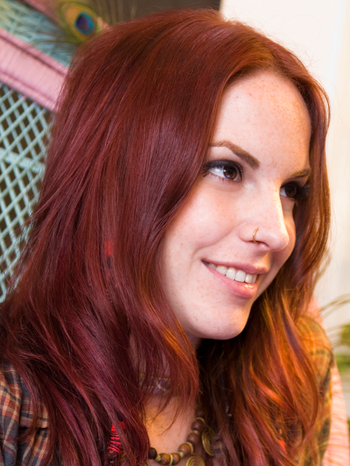Laura Katharina Steinmüller M.A.

Ancient Objects and Visual Studies (AOViS)
Building Archeology
Institut für Architektur
Straße des 17. Juni 152
10623 Berlin
04/2010 – 02/2012
HTW, Hochschule für Technik und Wirtschaft, Berlin;Master Konservierung und Restaurierung,Archäologisch – Historisches Kulturgut,Abschluss: Master of Arts
10/2006 – 02/2010
HTW, Hochschule für Technik und Wirtschaft, Berlin, Konservierung / Restaurierung und Grabungstechnik BA,
Archäologisch – Historisches Kulturgut, Abschluss: Bachelor of Arts
Praktika / Beruflicher Werdegang
04/2012 – 10/2012
Freiberufliche Tätigkeit als Restauratorin; Mitarbeit Restaurierung und Baufreimachung des Pergamonmuseums, Vorderasiatisches Museum Berlin
07/2008 – 10/2008
Reiss-Engelhorn-Museen Mannheim, Abt. Ausstellungsmanagement; Konservierung und Restaurierung pompejianischer Fresken
10/2005 – 07/2006
Museum für Vor- und Frühgeschichte Berlin, Staatliche Museen zu Berlin, Stiftung Preußischer Kulturbesitz; Konservierung und Restaurierung: Archäologisches Kulturgut
05/2005
Landesamt für Boden und Denkmalpflege Darmstadt; Archäologische Grabung
11/2004 – 01/2005
Hessisches Landesmuseum Darmstadt; Restaurierung: Archäologisches Kulturgut
From the raw material to cultural heritage - conservation studies on the Sasanian and early Islamic stucco decoration from Ctesiphon
Archaeological artifacts are subject to permanent transformation processes. As a rule, two essential stages of existence can be established in which the objects change not only materially but also in their meaning: Stage one begins with the idea, covers the production and use and ends with the stuccoes being reclaimed by the earth. Stage two opens with the excavations by the (now) Museum of Islamic Art in 1928/9 and 1931/2 and continues to the present. They reached a climax with the extensive reconstruction and restoration measures in the early 20th century.
An important part of the stucco finds from Ctesiphon have been restored and reconstructed for exhibition purposes immediately following the excavations. There are discrepancies such as seemingly arbitrary motif-complements or objects whose part of ‘original’-substance underlies the additions considerably. Subsequent retouches often confuse the viewer with a misleading completeness and obscures the fragmentary character. As ‘palimpsests’, on which previous generations of restorers have ‘inscribed’ by their measures, they frequently require new interventions.
This research project attempts to verify the existing hypotheses about the production, painting and dating by means of systematic visual investigations as well as current scientific methods and to substantiate them by means of scientific analyses. The central research objective here is the reconstruction of important sections of the object biography of the stucco decoration up to the present. A particular focus is on dealing with the controversial reconstructions of the 1930s. These are discussed in detail by means of the current debate on the concept of ‘authenticity’ in the museum landscape and the protection of cultural property.
Out of a total of nine sites within the Ctesiphon area, between two and six representative specimens have been chosen from each site, to which a detailed catalog of objects has been created. Through references of the archives of the Museum of Islamic Art, individual fragments of the archaeological notes can be matched to the reconstructed objects. One challenge is the fact that a large part of the excavated finds is located in the Baghdad Museum and the New York Metropolitan Museum. Research for the duration of one week in the United States allowed the documentation of the objects.
Methodological approach
A focus of the material research is on the original painting of the stuccoes, from which almost only the remains of the adhesive primer (gesso) can be seen today. With the help of the measuring center at the Institute of Chemistry of the Technische Universität Berlin as well as the analytical laboratory of the Hochschule für Technik und Wirtschaft Berlin, pigment determinations have been carried out under the inclusion of further finds such as wall painting fragments and color mixing pallets. It is apparent, that there has been a wide range of pigments used in Ctesiphon from Sasanian to early Islamic times.
In order to differentiate between the recent gypsum plaster base and the original stucco mortar, samples have been examined by the Department of Materials Engineering at the Faculty 2 of the HTW, using a scanning electron microscope. Further material analyzes for more precise mortar categorizations are being planned.
First results
The aspect of authenticity and communication in terms of archaeological objects, initiated by the research group’s discourse, has been reflected on the authors own material from the conservation/restoration point of view together with that of the monument preservation by Katharina Steudtner on the symposium “Museen – Orte des Authentischen” in Mainz (March 3-5, 2016; publication follows).
As collaborative work from the research project (C-3-1) on Ctesiphon, the special exhibition “Das Erbe der alten Könige. Ktesiphon und die persischen Quellen islamischer Kunst“, displays also a themed showcase with examples of the conservation-scientific work done on the stuccoes from Ctesiphon.
The thesis is being written within the Research Group C-3 Fragments, ruins and space: the perception and representation of ancient spaces in modern contexts of the Excellence Cluster 264 Topoi.
2012
L. Steinmüller, "Bergung und Rekonstruktion des Schädels Konrad von Burgsdorffs", in: A. Jeberien/M. Knaut (Hrsg.), Adel verpflichtet. Forschungen zur Konservierung und Restaurierung der barockzeitlichen Särge vom Schlossplatz Berlin – Mitte (München 2012) 93–105.
A. Jeberien/L. Steinmüller, "Bergung des Schädels Konrad von Burgsdorffs und Planungen zu dessen Rekonstruktion", in: A. Wieczorek/W. Rosendahl/A. Schlothauer (Hrsg.), Der Kult um Kopf und Schädel (Mannheim 2012) 51–64.
